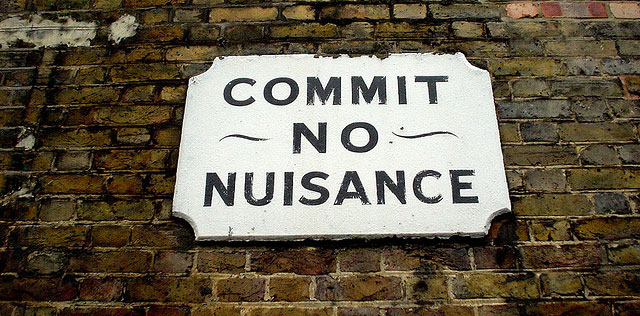
Is Your Neighbor Really A Nuisance?
We often see complaints from community associations regarding smoking, cooking smells or noise emanating from one unit to another. This leads to the question: what, if anything, can the association do? While many communities have restrictions in the governing documents prohibiting acts which may be or become an “annoyance” or “nuisance” to other residents in the community, the issue of whether or not something is actually a nuisance is very fact sensitive. Generally, if the transmission of smoke, smell or noise exceeds the average level a reasonable person would expect while living in a condominium (or other community association), then the resident creating the condition may be in violation of the nuisance restriction. So, the real question to ask: is the smoke, smell or noise is exceeding the average level a reasonable person would expect?
This is no easy task. The association must balance the ability of one owner to use their home, with the impact that such may have on other owners and whether such use is truly unreasonable. For example, in some instances, noise, smoking or odors may rise to the level of a nuisance because such can easily travel from one unit to the next, whether through thin walls or floors in the case of noise or under the door or through shared ventilation ducts or other openings in the case of smoke and odors. Of course, whether a particular instance would be a nuisance to other residents assumes that the impacted resident is a person with normal sensitivity to noise, smoke or odors and such does not exceed the average level that would be expected under the particular living conditions. Moreover, while we may wish that buildings were constructed in such a manner that unit-to-unit noise and odors were barely perceptible, even strict adherence to modern building codes does not assure that. Therefore, the association should consider several factors in order to objectively determine if the noise, smoke or odor is unreasonable, including but not necessarily limited to: (a) time of day, (b) continuity of the noise, smoke or odor, (c) the loudness of the noise, the amount of smoke or strength of the odor, and (d) whether the complaining owner suffers from a handicap (as that term is defined by the Federal Fair Housing Act) from which the effects of the noise, smoke or odors substantially limits the owners ability to use and enjoy a dwelling for which the association may be required to provide a reasonable accommodation.[1]
Where the association feels it can objectively determine that the noise, smoke or odor exceeds the level a reasonable person would expect while living in a condominium, then the association may alert the owner to the nuisance violation of the governing documents and recommend that all actions necessary to minimize the transmission of noise, smoke or odor from the unit into adjoining unit be taken. Those actions might include but are not limited to:
A. Installing carpeting or padding to reduce noise;
B. Limiting the smoking to a room or place in the unit that is least likely to cause the transmission of smoke or odor into other units and/or common areas;
C. Sealing all opening in walls or ceilings that adjoin other units. These openings might include areas around outlets, switches, ceiling light fixtures and vents;
D. Improving ventilation from whichever room the cooking/smoking may be occurring in to the outside. Of course, if any venting were to include venting to the exterior, the owner must contact the association with plans so it can review them to ensure that the installation will not negatively impact the common elements. While the association should be prepared to assist the owner in developing a plan to vent the smoke and odor to the outside, the owner would be responsible for these costs; and,
E. If the smoke is from medical marijuana, the owner should consult with their doctors to determine whether an ingestible form of marijuana can be used to achieve the same results.
In addition to any suggestions the Association may make, the association would also have an obligation to offer the parties involved alternative dispute resolution.[2]
If the association’s suggestions to resolve the issue are unsuccessful, the association, if authorized by its governing documents, may elect to issue fines or take other legal action against the unit owner.[3] These actions should only be taken if the association feels that it can objectively determine that the noise, smoke or odor exceeds the level a reasonable person would expect while living in a condominium. Accordingly, we strongly recommend that you consult with your attorney before taking any action to enforce nuisance restrictions in your governing documents.
[1] The Federal Fair Housing Act (42 U.S.C. §§3601-3619) and the regulations promulgated thereunder require “housing providers,” including entities such as condominium associations in New Jersey, to make “reasonable accommodations” to disabled persons in rules, policies, practices or services when such accommodations may be necessary to afford a person with a disability the equal opportunity to use and enjoy a dwelling. New Jersey’s Law Against Discrimination (N.J.S.A. 10:5-1 et seq.) similarly requires accommodation of the disabled. For example, if secondhand smoke worsens a resident’s medical condition, the association may be required to make a reasonable accommodation to reduce the amount of secondhand smoke.
[2] See N.J.S.A. 46:8B-14(k) (“As association shall provide a fair and efficient procedure for the resolution of housing-related disputes between individual unit owners and the association, and between unit owners, which shall be readily available as an alternative to litigation.”).
[3] Prior to the imposition of a fine, the association must provide written notice and offer alternative dispute resolution. N.J.S.A. 46:8B-15(f) (“A fine shall not be imposed unless the unit owner is given written notice of the action take and alleged basis for the action, and is advise of the right to participate in a dispute resolution procedure…”).





